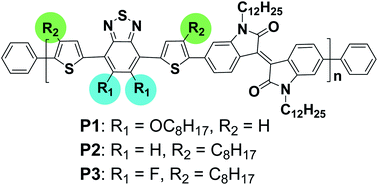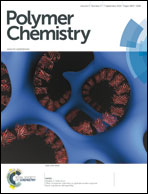Engineering the band gap and energy level of conjugated polymers using a second acceptor unit†
Abstract
Three novel isoindigo based donor–acceptor (D–A) conjugated polymers P1–3 have been synthesized by Suzuki polycondensation and utilized as donor materials for polymer solar cells (PSCs). These three polymers are of the same backbone, but have different substituents. All these polymers exhibit high thermal stability and broad absorption in the range of 300 to 770 nm. Hole mobilities of polymer films spin coated from 1,2-dichlorobenzene (DCB) solutions are 7.00 × 10−4, 2.37 × 10−3 and 2.90 × 10−4 cm2 V−1 s−1 for P1, P2 and P3, respectively. PSCs based on P2:PC71BM (1 : 2 by weight) with a 2% DIO additive displayed a power conversion efficiency (PCE) of 3.41% with a short-circuit current density (Jsc) of 7.57 mA cm−2, an open-circuit voltage (Voc) of 0.85 V, and a fill factor (FF) of 53%, under the illumination of AM 1.5G (100 mW cm−2). XRD diffraction measurements have shown that these polymers have a short π–π stacking distance in the solid state. The results demonstrate that these conjugated polymers could be promising donor materials in the application of polymer solar cells.


 Please wait while we load your content...
Please wait while we load your content...